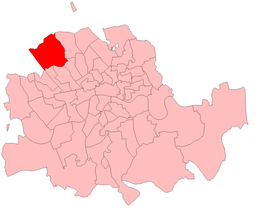Hampstead by-election, 1905

The Hampstead by-election was a Parliamentary by-election. It returned one Member of Parliament to the House of Commons of the United Kingdom, elected by the first past the post voting system.
Vacancy
Thomas Milvain had been Conservative MP for the seat of Hampstead since the Hampstead by-election, 1902. Milvain resigned the seat when he was appointed Judge Advocate General.[1]
Electoral history
The seat had been Conservative since it was created in 1885. They easily held the seat at the last election;
| Party | Candidate | Votes | % | ± | |
|---|---|---|---|---|---|
| Conservative | Thomas Milvain | 3,843 | 64.5 | ||
| Liberal | G.F. Rowe | 2,118 | 35.5 | ||
| Majority | 1,725 | ||||
| Turnout | 10,280 | 58.0 | |||
| Conservative hold | Swing | ||||
Candidates
- The local Conservative Association selected 63-year-old John Fletcher as their candidate to defend the seat. Fletcher had good local connections. He was a member of the Hampstead Board of Guardians from 1876-1898.[3] He was an elected member of the London County Council representing Hampstead for the Conservative backed Municipal Reform Party from 1889-1904. He served as one of the Council's deputy chairman from 1900-04.[4]
- The local Liberal Association selected G.F. Rowe as their candidate to gain the seat. Roe had been the Liberal candidate in the 1902 by-election.
Campaign
Rowe launched his campaign on 11 October with a public meeting at Hampstead Town Hall, sharing a platform with the London Liberal MP, Thomas Macnamara.[5] On 13 October he held his second public meeting at Brondesbury Hall. Fletcher's campaign, slower off the mark, sought to build upon his strong local links. He supported the Unionist government in its policy positions. He advocated the reduction in Irish representation in the UK parliament.[6] The Hampstead Temperance Council had invited both candidates to address their meeting, but Fletcher chose not to attend. The HTC gave its support to Rowe and Fletcher responded by seeking the support of local licensed vituallers. Rowe's third public meeting at West Hampstead Town Hall featured Leo Chiozza Money the Liberal candidate for neighbouring Paddington. Fletcher's first public meeting in Haverstock Hill, had him sharing a platform with Nottingham MP, Edward Bond and Keighley candidate William Mitchell Acworth.[7] Polling Day was fixed for the 26 October 1905. As Fletcher was a supporter of protectionism, Rowe received the endorsement of the Hampstead Free Trade League.[8] On 23 October Winston Churchill who had left the Conservatives and joined the Liberals primarily because of the free trade v protectionism issue, addressed a public meeting organised by the Hampstead Free Trade League.[9]
Result
The Liberals massively reduced the majority of the Conservatives, thanks to a swing of 11.9%;
| Party | Candidate | Votes | % | ± | |
|---|---|---|---|---|---|
| Conservative | John Samuel Fletcher | 4,228 | 52.6 | -11.9 | |
| Liberal | G.F. Rowe | 3,803 | 47.4 | 11.9 | |
| Majority | 425 | 5.2 | -23.8 | ||
| Turnout | 11,301 | 71.1 | +13.1 | ||
| Conservative hold | Swing | -11.9 | |||
The result should have been a good indicator to Unionist Prime Minister Arthur Balfour that the mood in the country was swinging behind the Liberals. He soon chose to resign as Prime Minister.
Aftermath
At the following General Election the result was similar;
| Party | Candidate | Votes | % | ± | |
|---|---|---|---|---|---|
| Conservative | John Samuel Fletcher | 4,934 | 52.5 | -0.1 | |
| Liberal | G.F. Rowe | 4,461 | 47.5 | 0.1 | |
| Majority | 473 | ||||
| Turnout | 11,467 | 81.9 | |||
| Conservative hold | Swing | ||||
References
- ↑ Encyclopædia Britannica 1911
- ↑ British parliamentary election results 1885-1918 by Craig
- ↑ Who is Who 1914 (66th ed.). London: Adam & Charles Black. 1914. p. 718.
- ↑ Debrett's
- ↑ "Election Intelligence." Times [London, England] 12 Oct. 1905: 8. The Times Digital Archive. Web. 19 Feb. 2014.
- ↑ "Election Intelligence." Times [London, England] 14 Oct. 1905: 7. The Times Digital Archive. Web. 19 Feb. 2014.
- ↑ "Election Intelligence." Times [London, England] 17 Oct. 1905: 11. The Times Digital Archive. Web. 19 Feb. 2014.
- ↑ "Election Intelligence." Times [London, England] 20 Oct. 1905: 6. The Times Digital Archive. Web. 19 Feb. 2014
- ↑ "Speech By Mr. Churchill." Times [London, England] 24 Oct. 1905: 10. The Times Digital Archive. Web. 19 Feb. 2014.
- ↑ British parliamentary election results 1885-1918 by Craig
- ↑ British parliamentary election results 1885-1918 by Craig